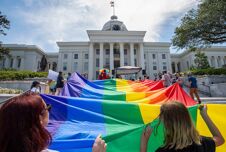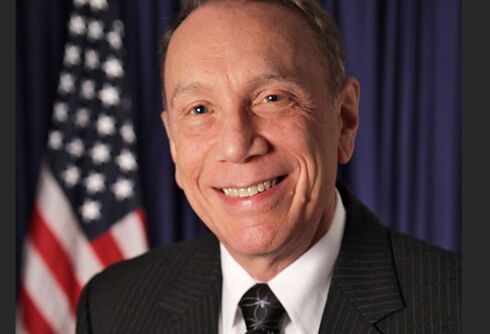The story of General Dwight D. Eisenhower’s failed “ferreting out the lesbians” attempt is perhaps the most famous slice of lesbian military lore to emerge from the 20th century. A near-perfect combination of patriotic hubris, calm feminist fortitude, and comedy, the legend unsurprisingly went “viral” throughout the queer community years before the internet was a thing. Especially popular was the story as told by lesbian icon and World War II WAC Sergeant Johnnie Phelps back in the 1980s.
But according to historians, it’s very likely untrue.
Related:
Unexpected allyship: How a California church became “the midwife of the modern LGBTQ movement”
Before the Stonewall Riots, there was the Vanguard Sweep. And it all started at the Glide Memorial Church.
The tale, featured prominently in documentaries like Before Stonewall and Free a Man to Fight: Women Soldiers of WWII, goes something like this: Under heavy executive pressure from President Harry S. Truman to eject “immoral” homosexuals from the American military, then-general Dwight D. Eisenhower confidently called a meeting of his reliable, no-nonsense female staffers from the Women’s Army Auxillary Corps (WAC) in 1947. The gathering notably included Nell Louise “Johnnie” Phelps, described as Eisenhower’s go-to woman for organizational support, as well as a pithy unnamed secretary.
Never Miss a Beat
Subscribe to our newsletter to stay ahead of the latest LGBTQ+ political news and insights.
Eisenhower, the picture of American masculinity in his starched uniform, summarized the danger that lesbians hiding within the WAC could allegedly cause the war effort, then asked Phelps to kindly begin compiling a list—“ferreting out”—of suspected individuals to be booted from service by the USA.
Phelps, moisturized and unbothered in her chair, allegedly replied: “If the General pleases I will be happy to do this investigation…but, sir, it would be unfair of me not to tell you my name is going to head the list. You should also be aware you’re going to have to replace all the file clerks, the section heads, most of the commanders, and the motor pool.”
Eisenhower’s secretary, note-taking the exchange, added “Sir…I have to type [the list], and I’ll be first.”
The women supposedly next underscored how lesbians produced zero unwanted pregnancies, spread no “venereal diseases,” and had already been awarded multiple commendations for excellent service by Eisenhower himself.
At this point Eisenhower told everyone to “forget the order.”
The vignette seems ripped directly from a critically-acclaimed Aaron Sorkin series. It was relayed by Phelps, then in her 60s, to writer Bunny MacCulloch in a 1982 interview reshared via feminist zines before weaving itself into dozens of books, documentaries, and articles about the nightmare of gay witch hunting in America.
Phelps’ biography spread with it, landing her on lists of notable queer veterans in museums and online and helping her secure a spot on the Los Angeles Commission on Veterans’ Affairs.
Born in 1922, the North Carolina native had originally volunteered for WWII service in 1943 to escape a young and unhappy heterosexual marriage, going on to find true lesbian love with a fellow WAC enlistee. That partner was, according to Phelps, killed in a bombing while the pair were stationed in the South Pacific together, with Johnnie herself nearly dying in a separate attack later that year. Honorably discharged from service in 1945 following her injury, Phelps reenlisted in 1946, which is when her assignment to assist in General Eisenhower’s office allegedly began.
Following her second honorable discharge, Phelps relocated to Southern California and started a successful printing business used to support lesbian and women’s rights efforts. She and her life partner, Grace Bukowski, joined the National Organization for Women (NOW) in the 1970s, founding the group’s Whittier, California, chapter in 1979.
After decades of work advocating for lesbian civilians and veterans, as well as service in the addiction community with the Alcoholism Center for Women, Phelps was honored in 1993 by Veterans for Human Rights with an awards banquet that once again spotlit her famous moment of clarity with General Eisenhower.
Unfortunately, memory and oral histories are often unreliable.
As it turns out, Phelps’ piece of now-ubiquitous gay history may be a marriage of myth, aspiration, and fact.
A decade after her death in 1997, military historian Donna Knaff went digging into Phelps’ story, reviewing hundreds of military documents and WAC records from WWII through Eisenhower’s tenure as president, finding several holes in the narrative.
Knaff writes: “While President Eisenhower issued Executive Order 10450, which addressed ‘sexual perversion’ among government employees, President Truman made no such order. Although admitted or discovered lesbians were often discharged from the Army during WWII…WAC company commanders were especially cautioned to avoid witch-hunting based amateur impressions of lesbianism.”
Knaff also unearthed copies of Phelps’ Soldier’s Qualification Card, which lists her highest rank as a corporal vs. the sergeant title she used for decades. The same records confirmed Phelps did serve overseas during the war effort, which at times would have made face-to-face meetings with Eisenhower impossible. Knaff additionally found statements from other WAC veterans slamming Phelps with vitriol, describing “nausea” at her claims that the women’s corps were well-populated with lesbians, and calling her story “one big lie.”
Today we generally recognize “nausea” in reaction to benign queer anecdotes as a red flag for reactionary homophobia, something carefully cultivated amongst service people and civilians alike during WWII. Racial segregation, sexism, and homophobia were well-documented pieces of the WWII experience regardless of location, and servicewomen were under particular pressure to remain femininely submissive even as their work defied traditional gender roles. The slightest suspicion of queerness could tarnish a woman’s career indefinitely, as well as her ability to marry or otherwise thrive in her own community, regardless of her actual sexual interests.
Phelps’ very colorful, and very public, assertion of a thriving lesbian population within the WAC and larger military therefore threatened the “good reputations” of thousands of women of the Greatest Generation. Knaff herself says, “Those [WAC veterans] who show such marked negative reaction to Johnnie Phelps may have internalized the values of a military that desired women to ‘free a man to fight,’ but which reviled lesbianism and ‘mannishness.’”
She goes on to explain that Phelps’s story “achieved the acclaim it did because it could, or should, have happened—had President Truman or General Eisenhower exercised appropriate leadership, this ‘nowhen’ even might actually have occurred.”
The uncomfortable, naked reality is that two things can be true at the same time. Johnnie Phelps was, in actuality, a pioneering lesbian advocate and servicewoman who devoted decades to improving the quality of life for queer women in America. She also, like millions of military men and women before her, fabricated war stories.
In the case of the “ferreting out the lesbians” legend, it seems clear Phelps’ intentions were good even if her methods were not, rooted in an effort to stop erasing queer women from a military where they very much existed.
Colonel Pat Jernigan writes that Phelps “answered her country’s call for help… served honorably in two separate enlistments; she reached the grade of corporal. These accomplishments are honorable.”
The story most famously attached to her, however, is just lesbian lore.
















